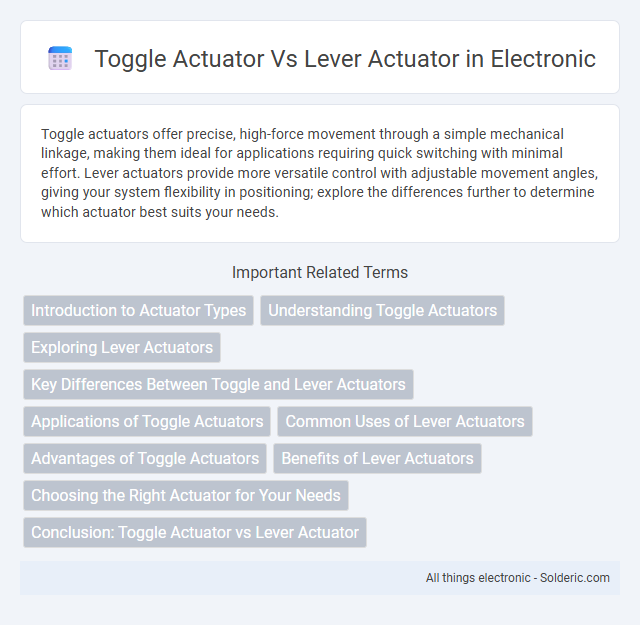Toggle actuators offer precise, high-force movement through a simple mechanical linkage, making them ideal for applications requiring quick switching with minimal effort. Lever actuators provide more versatile control with adjustable movement angles, giving your system flexibility in positioning; explore the differences further to determine which actuator best suits your needs.
Comparison Table
| Feature | Toggle Actuator | Lever Actuator |
|---|---|---|
| Operation Mechanism | Rapid switching using a spring-loaded toggle | Manual movement by pivoting a lever arm |
| Force Required | Low force due to spring action | Variable force depending on lever length |
| Durability | High, with defined snap action | Moderate, dependent on lever material |
| Typical Applications | Switches, circuit breakers, precision control | Industrial machinery, valve controls, mechanical linkages |
| Size & Design | Compact and enclosed | Usually larger and exposed |
| Control Precision | High repeatability due to toggle snap | Less precise, depends on operator control |
| Installation Complexity | Simple and often integrated | Requires mounting and alignment |
Introduction to Actuator Types
Toggle actuators provide precise, limited movement with a mechanical advantage ideal for applications requiring quick, strong positioning, while lever actuators offer broader, adjustable motion suitable for varied control mechanisms. Toggle actuators rely on a linkage system that locks into place, optimizing force transmission and stability, whereas lever actuators use a pivoting arm to convert input force into controlled output movement. Understanding the operational differences assists in selecting the appropriate actuator for industrial automation, robotics, and mechanical systems.
Understanding Toggle Actuators
Toggle actuators provide precise control by converting small input forces into larger output movements through a pivot mechanism, making them ideal for applications requiring high force amplification. Lever actuators rely on simple pivoting arms to transfer input motion directly, offering smoother and more straightforward operation but with less force multiplication compared to toggle actuators. Understanding toggle actuators helps you select the right actuator for tasks demanding quick engagement and strong mechanical advantage.
Exploring Lever Actuators
Lever actuators offer precise mechanical control by converting small input forces into amplified output motion, making them ideal for applications requiring fine adjustments. Their simple design with a pivoting arm provides durability and consistent performance in environments such as industrial machinery and automotive systems. Compared to toggle actuators, lever actuators deliver smoother operation and better modulation without the abrupt locking mechanism characteristic of toggles.
Key Differences Between Toggle and Lever Actuators
Toggle actuators provide a quick, positive on/off action with a distinct mechanical lock, ideal for applications requiring precise control and high force with minimal movement. Lever actuators offer smoother, continuous control over the range of motion, making them suitable for fine adjustments and variable positioning tasks. Your choice depends on whether you prioritize rapid switching or gradual, controlled actuation.
Applications of Toggle Actuators
Toggle actuators are widely used in applications requiring high force output with minimal input effort, such as clamping devices, presses, and mechanical locks. These actuators provide precise and reliable operation in assembly lines, packaging machinery, and automotive manufacturing where controlled motion and secure holding are essential. Your choice of a toggle actuator optimizes performance in systems demanding strong, quick, and repeatable actuation.
Common Uses of Lever Actuators
Lever actuators are widely used in industrial machinery, automotive systems, and HVAC controls due to their precise mechanical advantage and simplicity. Your control over valve positioning, switch activation, or mechanical linkages is enhanced by the lever actuator's ability to convert small input forces into significant output motion. These actuators excel in applications requiring manual or automated adjustments with reliable, repeatable performance.
Advantages of Toggle Actuators
Toggle actuators provide precise control and high force output with minimal input effort due to their mechanical advantage, making them ideal for applications requiring firm locking or clamping. Their compact design and reliable performance under repetitive cycling reduce wear and maintenance costs compared to lever actuators. Toggle actuators also excel in ensuring consistent positioning and safety by locking automatically when engaged, enhancing operational stability in industrial machinery.
Benefits of Lever Actuators
Lever actuators offer precise control and ease of operation, making them ideal for applications requiring manual adjustments. Their ergonomic design reduces operator fatigue and increases efficiency during repetitive tasks. Lever actuators also provide consistent torque transmission, enhancing the reliability and durability of mechanical systems.
Choosing the Right Actuator for Your Needs
Choosing the right actuator depends on the specific application requirements such as load capacity, speed, and control precision. Toggle actuators excel in providing high holding force and are ideal for applications requiring secure locking mechanisms, while lever actuators offer smoother operation and versatility in motion control. Understanding your system's mechanical constraints and performance goals ensures that Your selection maximizes efficiency and reliability.
Conclusion: Toggle Actuator vs Lever Actuator
Toggle actuators provide precise control and greater force amplification, making them ideal for applications requiring high torque in confined spaces. Lever actuators offer simpler design and smoother operation, suitable for tasks needing less force and more straightforward actuation. Your choice depends on whether you prioritize power and precision (toggle) or simplicity and ease of use (lever).
toggle actuator vs lever actuator Infographic

 solderic.com
solderic.com